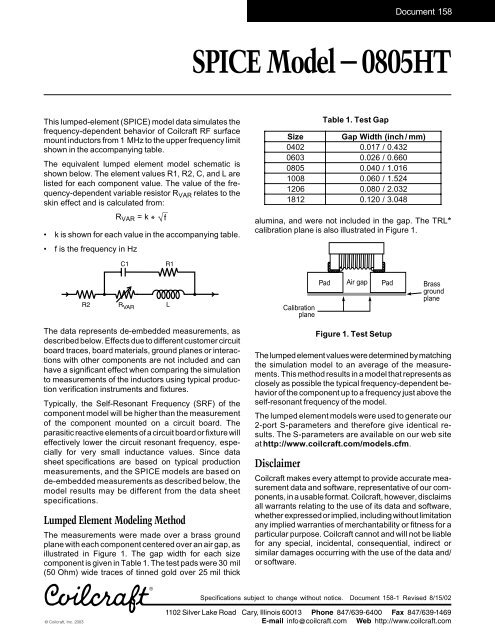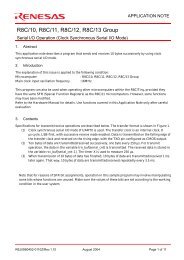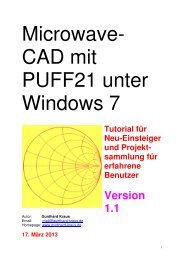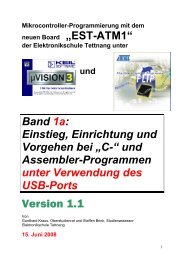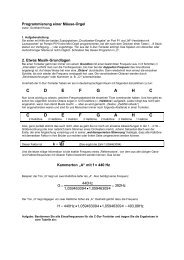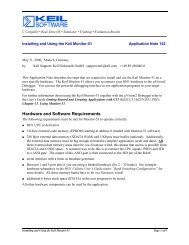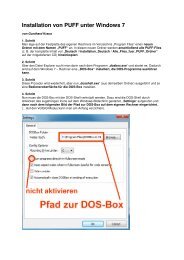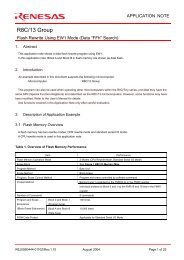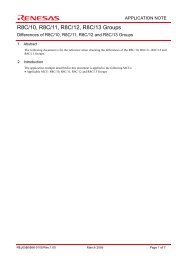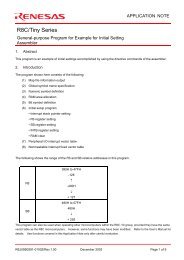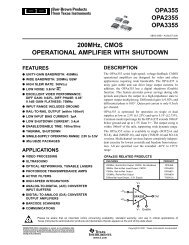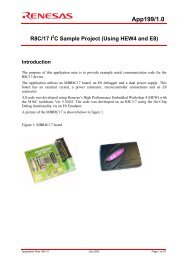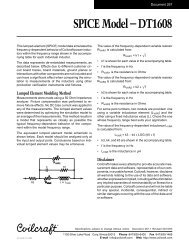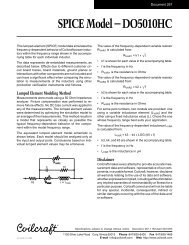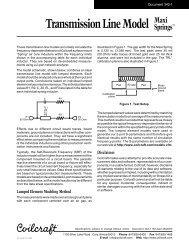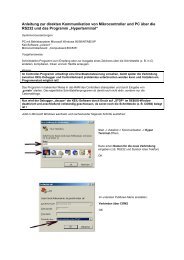SPICE Model – 0805HT - von Gunthard Kraus
SPICE Model – 0805HT - von Gunthard Kraus
SPICE Model – 0805HT - von Gunthard Kraus
You also want an ePaper? Increase the reach of your titles
YUMPU automatically turns print PDFs into web optimized ePapers that Google loves.
Document 158<br />
<strong>SPICE</strong> <strong>Model</strong> <strong>–</strong> <strong>0805HT</strong><br />
This lumped-element (<strong>SPICE</strong>) model data simulates the<br />
frequency-dependent behavior of Coilcraft RF surface<br />
mount inductors from 1 MHz to the upper frequency limit<br />
shown in the accompanying table.<br />
The equivalent lumped element model schematic is<br />
shown below. The element values R1, R2, C, and L are<br />
listed for each component value. The value of the frequency-dependent<br />
variable resistor R VAR relates to the<br />
skin effect and is calculated from:<br />
R VAR = k *<br />
• k is shown for each value in the accompanying table.<br />
• f is the frequency in Hz<br />
Table 1. Test Gap<br />
Size<br />
G ap Width (inch/ mm)<br />
0402<br />
0.017 / 0.432<br />
0603<br />
0.026 / 0.660<br />
0805<br />
0.040 / 1.016<br />
1008<br />
0.060 / 1.524<br />
1206<br />
0.080 / 2.032<br />
1812<br />
0.120 / 3.048<br />
alumina, and were not included in the gap. The TRL*<br />
calibration plane is also illustrated in Figure 1.<br />
Calibration<br />
plane<br />
Pad Air gap Pad Brass<br />
ground<br />
plane<br />
The data represents de-embedded measurements, as<br />
described below. Effects due to different customer circuit<br />
board traces, board materials, ground planes or interactions<br />
with other components are not included and can<br />
have a significant effect when comparing the simulation<br />
to measurements of the inductors using typical production<br />
verification instruments and fixtures.<br />
Typically, the Self-Resonant Frequency (SRF) of the<br />
component model will be higher than the measurement<br />
of the component mounted on a circuit board. The<br />
parasitic reactive elements of a circuit board or fixture will<br />
effectively lower the circuit resonant frequency, especially<br />
for very small inductance values. Since data<br />
sheet specifications are based on typical production<br />
measurements, and the <strong>SPICE</strong> models are based on<br />
de-embedded measurements as described below, the<br />
model results may be different from the data sheet<br />
specifications.<br />
Lumped Element <strong>Model</strong>ing Method<br />
The measurements were made over a brass ground<br />
plane with each component centered over an air gap, as<br />
illustrated in Figure 1. The gap width for each size<br />
component is given in Table 1. The test pads were 30 mil<br />
(50 Ohm) wide traces of tinned gold over 25 mil thick<br />
The lumped element values were determined by matching<br />
the simulation model to an average of the measurements.<br />
This method results in a model that represents as<br />
closely as possible the typical frequency-dependent behavior<br />
of the component up to a frequency just above the<br />
self-resonant frequency of the model.<br />
The lumped element models were used to generate our<br />
2-port S-parameters and therefore give identical results.<br />
The S-parameters are available on our web site<br />
at http://www.coilcraft.com/models.cfm.<br />
Disclaimer<br />
Figure 1. Test Setup<br />
Coilcraft makes every attempt to provide accurate measurement<br />
data and software, representative of our components,<br />
in a usable format. Coilcraft, however, disclaims<br />
all warrants relating to the use of its data and software,<br />
whether expressed or implied, including without limitation<br />
any implied warranties of merchantability or fitness for a<br />
particular purpose. Coilcraft cannot and will not be liable<br />
for any special, incidental, consequential, indirect or<br />
similar damages occurring with the use of the data and/<br />
or software.<br />
Specifications subject to change without notice. Document 158-1 Revised 8/15/02
Document 158<br />
<strong>SPICE</strong> <strong>Model</strong> for Coilcraft <strong>0805HT</strong> Chip Inductors<br />
Upper<br />
R1 R2 limit<br />
Part number () () C (pF) L (nH) k (MHz)<br />
<strong>0805HT</strong>-1N8 6 0.03 0.072 1.8 6.04E-06 14700<br />
<strong>0805HT</strong>-3N9 7 0.05 0.045 4.0 1.22E-05 12500<br />
<strong>0805HT</strong>-4N7 8 0.06 0.048 4.5 1.36E-05 11400<br />
<strong>0805HT</strong>-6N8 8 0.08 0.045 6.9 2.11E-05 9500<br />
<strong>0805HT</strong>-8N2 9 0.08 0.052 8.2 2.50E-05 8100<br />
<strong>0805HT</strong>-10N 9 0.08 0.088 9.9 2.34E-05 5700<br />
<strong>0805HT</strong>-12N 10 0.10 0.047 12.0 2.86E-05 7100<br />
<strong>0805HT</strong>-15N 10 0.10 0.076 14.6 3.14E-05 5100<br />
<strong>0805HT</strong>-18N 11 0.13 0.053 17.6 3.74E-05 5500<br />
<strong>0805HT</strong>-22N 11 0.15 0.040 22 4.79E-05 5400<br />
<strong>0805HT</strong>-27N 16 0.19 0.065 27 5.59E-05 4000<br />
<strong>0805HT</strong>-33N 20 0.19 0.058 33 6.31E-05 3900<br />
<strong>0805HT</strong>-39N 24 0.27 0.050 40 7.21E-05 3800<br />
<strong>0805HT</strong>-47N 28 0.30 0.048 47 1.01E-04 3600<br />
<strong>0805HT</strong>-56N 20 0.39 0.050 56 1.17E-04 3200<br />
<strong>0805HT</strong>-68N 16 0.40 0.061 68 1.44E-04 2600<br />
<strong>0805HT</strong>-82N 18 0.44 0.051 81 1.72E-04 2600<br />
<strong>0805HT</strong>-R10 20 0.64 0.059 101 1.84E-04 2200<br />
<strong>0805HT</strong>-R12 22 0.68 0.056 120 1.96E-04 2100<br />
<strong>0805HT</strong>-R15 25 0.80 0.054 146 1.98E-04 1900<br />
<strong>0805HT</strong>-R22 34 1.29 0.064 215 2.44E-04 1500<br />
Specifications subject to change without notice. Document 158-9 Revised 11/13/02


